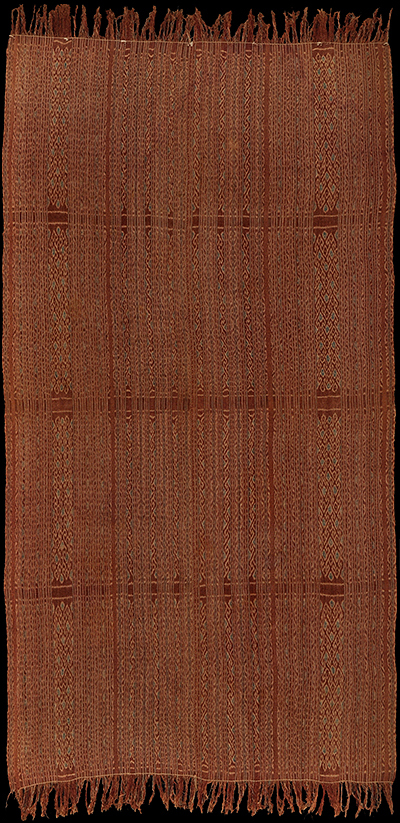| |
 
 | | | |
224 Timor, West Timor
Bete krao (blanket)  
| | Locale: | Manulea (Malaka Tengah), Atoin Meto people | | Period: | Late 19th to early 20th c. | | Yarn: | Cotton, hand-spun, medium | | Technique: | Weft ikat | | Panels: | 2 | | Size: | 116 x 220 cm (3' 9" x 7' 2") LW: 1.90 | | Weight: | 1110 g (39.2 oz), 435 g/m2 (1.43 oz/ft2) | | Design: | Manulea striped menís cloths with numerous ikated bands and stripes are a classic type of Timor textile, prized for their unusually detailed, sharply defined ikat. Their use of green is a distinctive characteristic of Manulea weaving. The wider bands are decorated with what appears to be a variant of the typically Timorese kaif motif. Manulea is the informal name for a group of districts that form an Atoni area within the otherwise Tetun Malaka, which is the heartland of the Tetun people who arrived in Timor in the 14th c. It has a distinctive textile tradition that reflects Manuleaís political separation from the dominant central and eastern Timor culture since at least the mid 18th c, the trademark of these textiles being their rich red-brown color (also found in other Atoni areas) and particularly their very fine weaving. | | Comment: | Antique Manulea beti in excellent condition. Remarkable is that it is 'full-asli': hand spun yarn and vegetable colours only. Manulea was one of the Timor regions where commercial yarn was adopted early: nearly all ikat from 1950 and later is done in commercial yarn. According to Threads of Life (website), Manulea weavers in the past would take recourse to up to twenty consecutive dye baths to obtain the desired depth of morinda saturation.
Often confused with Biboki cloths, Manulea bete krao can be recognized by the unique touches of blueish green. A thin but heavy cloth. Under microscope textile looks like a jungle of intertwined vines of various diameter. | | Background: | Chapters on Timor and West Timor. | | Exhibited: | Timor: Totems and Tokens, Museu do Oriente, Lisbon, 2019/20. | | Published: | Ikat Textiles of the Indonesian Archipelago, 2018.
Timor: Totems and Tokens, 2019.
Ikat Textiles of Timor: Indonesian and Timor-Leste, 2025. | | Compare: | 150 | | Sources: | Very similar to pre-1930 bete krao in Rijksmuseum Volkenkunde, RV-2197-2, as well as to a speciment in the Yale University Art Gallery, Acc. nr. ILE2019.12.196, which however is disfigured by a bleached out spot in the middle. Similar example (detail) in Yeager & Jacobson, Textiles of Western Timor, Plate 226. Another similar cloth from this region, but much younger, and executed in commercial yarn, is depicted in Hamilton and Barrkman, ed., Textiles of Timor, Fig. 7-34. | | |

©Peter ten Hoopen, 2025
All rights reserved.
|
|


